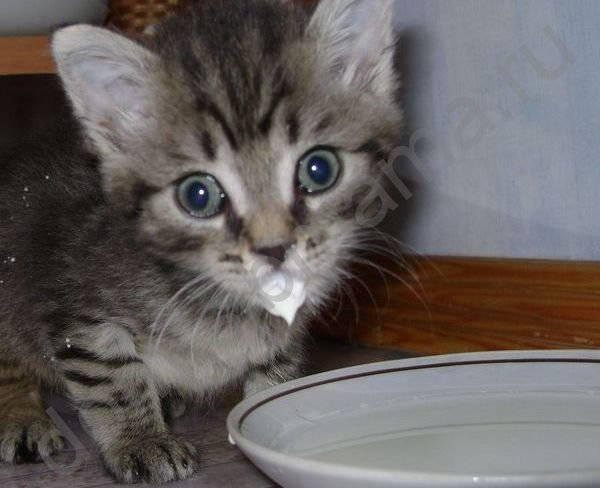The mother of the kitten will also let you know how comfortable she is when you pick up her babies. It is important to do this slowly, especially at first. If the mother cat seems agitated or tense, give her and her babies some space.
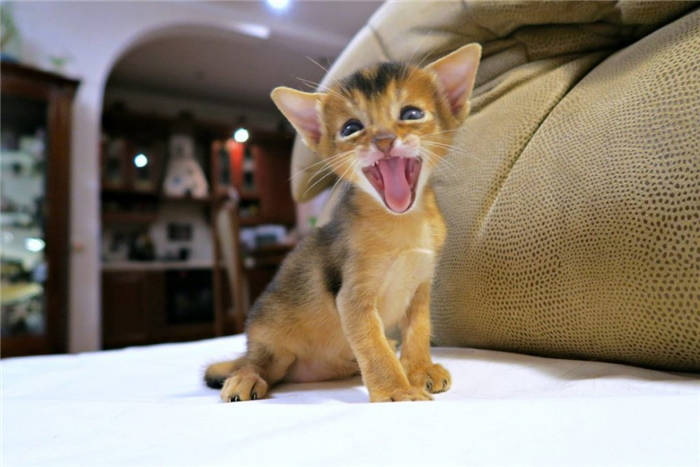
- Feeding newborn kittens from a bag: personal experience
- Feeding newborn kittens
- Pick up the kitten and provide first aid
- How and what should I feed my kitten?
- Special milk substitutes for kittens
- Why you shouldn't feed cow's milk
- Features and rules of feeding
- The set of necessary
- Steps
- Tummy massage combined with fur and eye care
- Silence, peace for kittens.
Feeding newborn kittens from a bag: personal experience
Lately, I've been seeing more and more people finding discarded blind kittens. It turns out that irresponsible owners who allowed a cat to become pregnant and who didn't think of a modern method such as spaying the animal, dump the problem on more responsible people who just can't get past the living soul.
It was in June, it was very cold outside, and it was raining in small quantities. My daughter's girlfriends came over and went for a walk with the dogs in the field.
Half an hour later, the girls ran home excited, grabbed some box and ran back.
Five minutes later, I was already looking at two black lumps. One was crying very loudly, the second was very lethargic and hardly moved. There was also a third, who didn't wait for help… He stayed in the bag in which they had been thrown out, having previously tied it up so they wouldn't crawl out.
The kittens were blind, with a little dried umbilical cord, which dried in 3-4 days, so we concluded that the kittens were only a couple of days old. The black one with white paws squeaked, he attracted the attention of the girls. And the little black one was already barely breathing, and we had to fight for his life.
Why, people. If you allowed the babies to be born, let the cat feed them and at least try to place them. How can you tie up a bag and throw out the live ones? Don't you have nightmares?
The girls ran out and bought dairy-free porridge for human babies from 0 months. That's what we started feeding the kittens every 2 hours. At night there was no break, we also fed every 2 hours.
After each feeding you should take a piece of cloth and massage the tummy in the direction of the tail. This stimulates the bowel function, without it kittens just can't go to the toilet by themselves. At first we massaged the tummy with wet, warm discs to remove makeup.
But by evening we were lucky, the role of mommy cat was taken over by our dog. I still don't understand how my daughter decided to let the dog sniff the baby.
Feeding newborn kittens
1. there is no definite opinion, as the cat mom does not feed them by the hour, when they start to cry, then they are hungry. But it turns out that approximately every 2 hours. At night we also feed every 2 hours. One kitten is enough 3-4 ml. mixture or milk substitute for each reception.
2. Somewhere around day 5-6, the kittens wake up less often, you can expect to be out of the house for three hours. We continue to feed the babies at night.
3. At 2 weeks, you can begin to reduce night feedings and transfer kittens to one feeding at night.
4. From 3 weeks, you should introduce supplementation in the form of light cottage cheese (it is convenient to buy baby, without additives), a little later you can give baby meat puree, boiled fish without bones and skin, minced beef. Somewhere in a month or later, kittens can already eat themselves from a bowl.
5. After one month of age, you can try to eliminate night feeding, if you do not get it right away, then do not torture the kittens, feed more at night for a few days.
It so happened that if we had not weighed the kittens before and after meals, we would have lost one for sure, as the first few days he ate very badly, was lethargic, apparently, still had time to freeze.
Everything we gave him ended up unnoticed around, but not in the baby's stomach. We literally fought for every milligram we ate, for every drop.
Kittens are getting older, increase the rate of formula,. As a rule, healthy kittens can control how much food they need by themselves. The main thing is to feed the babies, and then you can limit their food.
Keep in mind that at the first opportunity it is better to change the infant formula for a special cat milk substitute. It contains all the necessary vitamins and minerals, and has detailed instructions on what age, how much formula to make.
Pick up the kitten and provide first aid
In the first three weeks of life, a kitten does not know how to regulate body temperature. The first step is to reduce the risk of hypothermia. Wrap the kitten in a warm blanket. At home, put the kitten in a warm place. You can use a heater or a bottle of hot water wrapped in a towel as a source of heat.
The kitten should not be fed until it has warmed up. A chilled body will not be able to digest food efficiently.
Show your kitten to the vet as soon as possible to rule out injury and dehydration, and check for fleas and other parasites. Kittens lose fluids quickly, and dehydration can be dangerous.
At home, keep your kitten in a carrier or box with a warm blanket or towel. If there are other animals in the house, the kitten should be isolated. You need to change the bedding every day, because the kitten does not go to the litter box, but does things wherever it has to.
How and what should I feed my kitten?
You can't feed a kitten cow's milk. It is not nutritious enough for a cat's body. Cow's milk can cause diarrhea in the baby, and this is dangerous for such a small body.
To feed a kitten, you will need formula and a bottle or dropper. All of these can be bought at pet stores.
Sterilize the bottle and nipple before you feed your kitten. Hygiene is very important: any harmful bacteria can be dangerous to an immature kitten. Wash your hands before feeding. It's also a good idea to have separate, clean clothes for feeding and other procedures. This reduces the risk of introducing harmful bacteria into your kitty's body.
To feed your kitten, gently open her mouth and offer her a pacifier. The kitten will feel the food and begin to eat. Hold the bottle at a 45-degree angle to keep air out of the intestines. Don't rush your baby, let him eat at a pace he is comfortable with.
If the kitten refuses to eat, try stroking his forehead and back. These movements mimic the behavior of a mother cat and therefore stimulate appetite. If within 10-12 hours the kitten did not eat, it is an alarm signal, and you need to show the vet immediately.
Special milk substitutes for kittens
There are 11 grams of fat and protein and 3.4 grams of lactose in 100 grams of cat milk. In addition, it contains vitamins, minerals and amino acids necessary for the growth and development of the baby. Neither baby formula nor cow's or goat's milk has this composition. The only way to provide kittens with adequate nutrition is to feed them a special substitute. You can buy it at the drugstore or pet store.
Why you shouldn't feed cow's milk
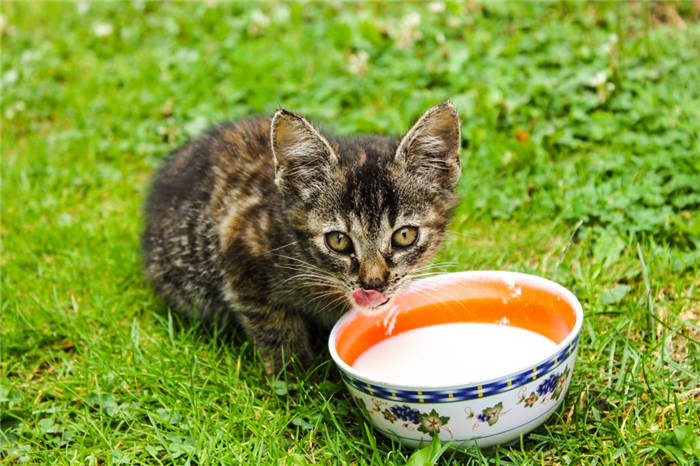
When figuring out how to feed kittens, you need to know what to feed one-week-old kittens if they are unexpectedly abandoned by the cat.
Young kittens, up to about 3-4 weeks old, have absolutely no free hydrochloric acid in their stomachs, which is what the digestion process is made of.
Kittens are not suitable for cow's milk for two reasons. It does not contain enough proteins and fats, and does not contain the necessary vitamins, minerals and amino acids. By eating cow's milk, the animal will not get enough micronutrients, which are so important for its growth and development. It has too much lactose, and it is not absorbed in this amount by kittens. The baby may get diarrhea, vomiting or allergies.
Features and rules of feeding
In order not to get confused at the most inopportune moment and not to expose their tiny pets to danger, it is worth finding out in advance what recommendations should be followed in such cases. This concerns not only the regime itself, the composition of mixtures, but also the correct procedure and manipulation after its implementation.
The set of necessary
For feeding a kitten, you can use one of the devices:
It is optimal to choose the first option, but it is not available to everyone, so you will have to fork out with what is available. With the other two, it will not hurt to be extremely careful, so that the liquid does not get into the airways, and the animal does not choke.
Steps
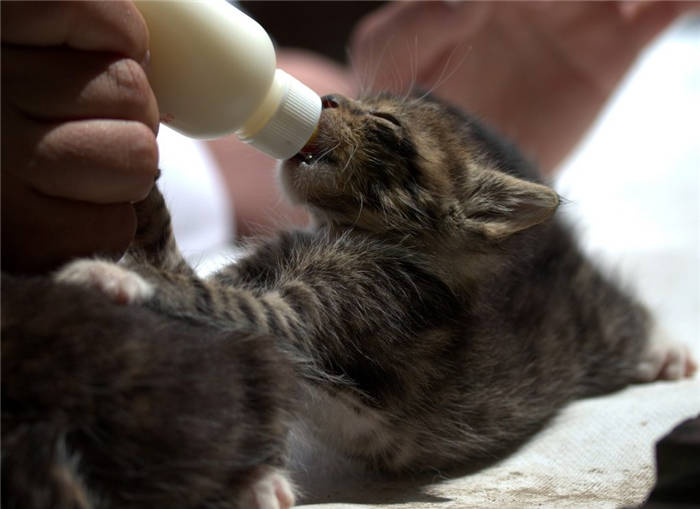
First, it is necessary to sterilize the selected tool, for which it should be scalded with boiling water. From there, you can proceed according to the algorithm presented:
- Prepare milk replacer according to the instructions.
- Heat the resulting product to 37 ° C. It is optimal to do this in a water bath, but the microwave is not very suitable for such purposes. It can unevenly heat the contents of the container. If there is no choice, then after you take the bottle out of the device, try to stir the contents intensely.
- Carefully check your baby's body temperature. If he has cold feet, the food will become much worse absorbed, so first you need to warm him up. To do this, install an electric heating pad or simply put a plastic "cup and a half" with warm water in a box or house.
- Lay a clean cloth, for example, it can be a towel, and on top of it put the kitten belly down, slightly raising his head, because this is the natural position for him to feed from his mother.
At the first feeding, a drop of the formula is placed on the pet's nose so that he can smell it. Only then will he start looking for the nipple and grab it with his mouth.
Tummy massage combined with fur and eye care
In normal circumstances, the mother cat licks all the kittens' fur, eyes, and mouth, thus not only cleansing them, but also massaging them. Massaging the tummy and crotch area is necessary for the kitten to relax and go to the toilet. Without massage, he does not know how to regulate his muscles.
Orphans can be massaged with a barely damp cloth, and their eyes can be wiped with damp absorbent cotton. The kitten itself will begin to wash at 20 – 25 days. Our kitten Moor (which we kept, and gave the second in a month and a half) began to wash from the eighth day, was captured on this day – for the story.
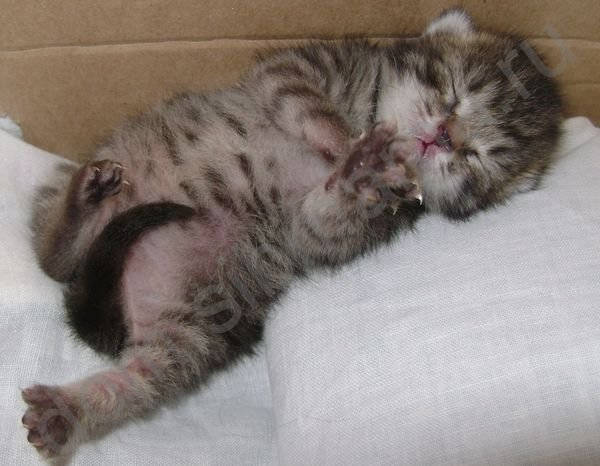
In the first 2-3 days the umbilical cord falls off, so the first few days the belly should be wiped especially carefully. The procedure should be done after each time the kittens wake up, prompting them to urinate. By 4 weeks old, kittens can control their urge to go to the toilet, so you can begin to accustom kittens to the litter box at this age. We began even earlier, at 2 weeks, when the kittens' eyes had just opened, so that the kittens would get used to the sight of the litter box, that the smell of the toilet should be located only in one limited place.
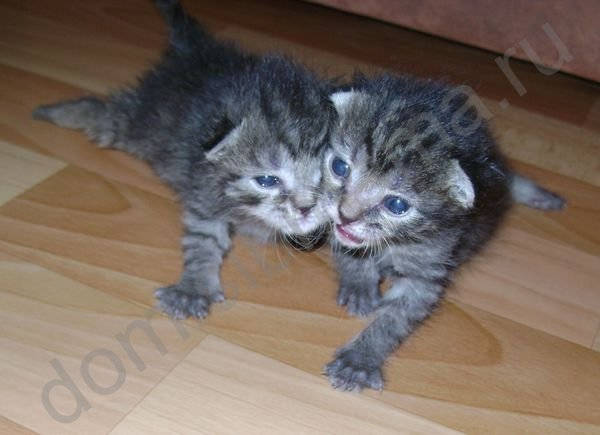
When we went to live in the country, we took the litter box with us. As soon as the kittens woke up, we carried them to the litter box and massaged their bellies and the crotch area, and they knew, that after sleeping they had to go to the bathroom, a pleasant feeling of relief of bladder and bowels was automatically remembered and associated with the litter box. This way we practically "led by hand" the kittens to the bathroom, so that by the age of a month and a half Moor began to go to the toilet by himself one day. I watched him for a couple of days, no mistakes happened. Of course, then there were a couple of misses, but I washed everything with soap and water, put a lid with a few drops of vinegar, and that place Mavrik forgot.
Silence, peace for kittens.
If there are small children in the house, explain to them that you can take the kitten in your arms only for grooming and feeding, for play, babies are not yet strong. There is also no need to carry a nest box with the kittens. Kittens' sleep is shallow, restless, with dreams, apparently. They are already twitching their paws, waking themselves, looking for their mother, looking for something to suckle on, so there is nothing to disturb them and wake them specifically. The first days the outer ear of kittens is not developed, the ear canal is not distinguished, hearing will be to 9-11 days. But still need to be relatively quiet, do not jump or stomp near the kittens, do not move the box – kittens feel the vibration. The box needs something to cover the top, at least a dark cloth, so that the bright light does not damage the eyes. The eyelids will open by a week to two weeks of age, and kittens will be able to see well in another 5-10 days. If their eyes or one eye does not open by the 17th day, you need to see a veterinarian.
The hardest part for us was getting the kittens to lap up milk and eat solid food from a saucer. They loved the bottle. We put the food in their mouths in small peas. Why would they refuse such pleasure?
In general, kittens, obeying the sense of hunger, begin to lap themselves at 3-3.5 weeks from the saucer. But with us they cried shrilly, poked in a saucer, sneezed from the milk in his nose and could not understand what to do. There was no one to show them how to lap, no adult cats or dogs around. A week of unsuccessful attempts passed, but here we came to us guests – experienced cat breeders and half an hour taught kittens to fondle from a saucer. You have to dip your finger into the saucer and give it to the hungry kitten. Gradually decrease the distance from saucer to finger until the kitten understands what to do. The first time Moor got so tired of pawing that he fell asleep with two paws in the saucer.
